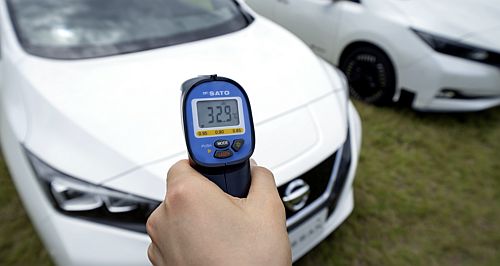News - NissanNissan’s cooling paint reduces cabin tempsTrials of cooling paint begin, Nissan says new technology can reduce cabin temps by 5 degrees7 Aug 2024 IMPORTANT for a climate changing planet, and hot places like Australia, is Nissan’s innovative cooling paint technology that is currently being trialled with a view to making it available on special order in a variety of colours.
With outside help, the boffins at Nissan in Japan have figured out that embedded metamaterial, synthetic composite materials with structures that exhibit properties not usually found in nature, when added to automotive paint help lower cabin temperatures and reduce energy usage, thereby taking the heat out of summer.
Focus of the trial has been determining how much the new product helps lower a vehicle’s ambient cabin temperature (in summer) and concurrently reduce the energy usage of the vehicle’s air-conditioning system.
Nissan enlisted the help of partner Radi-Cool, a specialist in radiative cooling products in developing the paint, the project a part of Nissan’s pursuit of “differentiated innovations that empower journeys and to help create a cleaner more sustainable society”.
Last November, Nissan started a year-long feasibility trial of the product at Tokyo’s Haneda Air Terminal. The trial roped in several participants including Japan Airport Terminal, Radi-Cool Japan and All Nippon Airways (ANA) airport service with the cool paint applied to a Nissan NV100 service vehicle operated by All Nippon Airways (ANA) airport services.
Haneda has large areas of open tarmac providing the perfect environment to conduct real-world evaluation of the paint’s performance in an exposed high-temperature environment.
Nissan point out the paint is still in testing phase but the results to date have been impressive as the test vehicle, parked side-by-side under the sun with a standard paint model has shown yields of up to a 12-degree Celsius reduction in exterior surface temperatures and up to five-degree Celsius cooler interior, compared to the standard vehicle.
Nissan says the paint’s cooling performance is particularly noticeable when a vehicle is parked in the sun for an extended period.
“A cooler cabin is not only more pleasant to enter, but also requires less air-conditioning run-time to cool the cabin to a comfortable temperature,” it said in a statement.
“This helps reduce load to the engine, or in the case of an electric vehicle, draw on the battery. In both powertrains, an improvement in efficiency is expected, as well as occupant comfort.”
From a more technical standpoint, the metamaterial embedded within the cool paint features two microstructure particles that react to light. One particle reflects near-infrared rays in the sunlight that would typically cause molecular level vibrations within the resin of traditional paint to produce heat.
The second particle is a breakthrough creating electromagnetic waves that counteract the sun’s rays, redirecting the energy away from the vehicle into the atmosphere.
When combined in the cool paint, they reduce the transfer of heat into surfaces such as the roof, bonnet, doors and panels.
Dr Susumu Miura, senior manager and expert at the Advanced Materials and Processing Laboratory, Nissan Research Centre is in charge of the paint development program and in the past has played a leading role in Nissan’s noise-reducing acoustic material, dedicating much of his career at Nissan to exploring ways to make cars quieter, cooler and more efficient.
“My dream is to create cooler cars without consuming energy” explained Dr Miura. “This is especially important in the EV era, where the load from running air-conditioning in summer can have a sizable impact on the state of charge.”
While radiant cooling paint isn’t new, it is typically used for buildings and structures and is often very thick requiring application by a paint roller. Devoid of any clear topcoat, it can leave a chalky residue when touched.
Key challenges Dr Miura had to consider when developing an automotive version, was to ensure it could incorporate a clear topcoat, be applied via a spray gun (not a roller) and meet Nissan’s rigorous internal standards for paint quality.
The cool paint program was commenced in 2021 with Dr Miura and his team testing over 100 samples since, currently evaluating a thickness of 120 microns which is approximately six times thicker than typical automotive paint.
They have confirmed the product’s resistance to salt and chipping, peeling, scratches, chemical reactions, along with colour consistency and repairability.
Dr Miura’s team continue to explore thinner options that deliver the same level of cooling performance and see strong potential, particularly for light commercial vehicle applications such as vans, trucks and ambulances that exist outside most of the time.  Read more31st of July 2024  Nissan’s slow US sales torpedo global profitsSoftening North American market, unsold inventory sees 99pc cut to Nissan’s operating profit25th of June 2024  2024 Nissan Pathfinder Ti ReviewNissan’s Pathfinder straddles the gap between on-road family hauler and weekend adventurer |
Click to shareNissan articlesResearch Nissan Motor industry news |
















Facebook Twitter Instagram